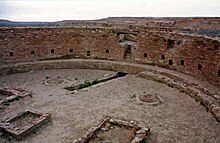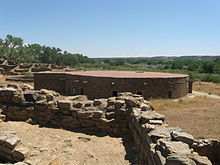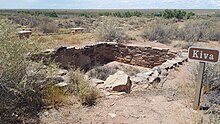






A kiva is a space used by Puebloans for rites and political meetings, many of them associated with the kachina belief system. Among the modern Hopi and most other Pueblo peoples, "kiva" means a large room that is circular and underground, and used for spiritual ceremonies and a place of worship.
Similar subterranean rooms are found among ruins in the Southwestern United States, indicating uses by the ancient peoples of the region including the ancestral Puebloans, the Mogollon, and the Hohokam.[1] Those used by the ancient Pueblos of the Pueblo I Period and following, designated by the Pecos Classification system developed by archaeologists, were usually round and evolved from simpler pit-houses. For the Ancestral Puebloans, these rooms are believed to have had a variety of functions, including domestic residence along with social and ceremonial purposes.[2]
- ^ Pecina 2012.
- ^ Markovich, Nicholas; Preiser, Wolfgang; Sturm, Fred (2015). Pueblo Style and Regional Architecture. Routledge. ISBN 978-1-317-39883-7.